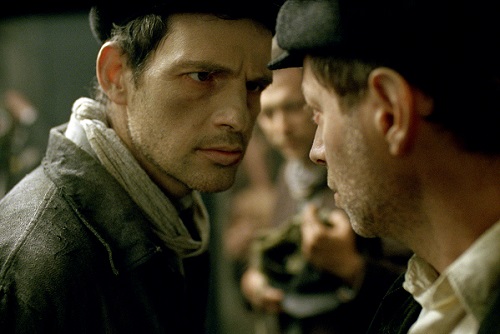Synopsis: In the horror of 1944 Auschwitz, a prisoner forced to burn the corpses of his own people finds moral survival upon trying to salvage from the flames the body of a boy he takes for his son.
Release Date: January 15, 2016 MPAA Rating: PG-13
Genre(s): Drama, History
Film Review

Production
Nothing brings a crowd of happy moviegoers down quite like a film about the Holocaust. One only needs to look so far as Schindler’s List or Sophie’s Choice to see that. And it’s not just American movies that capture that weight; Hungary’s Academy Award nominee for Best Foreign Language Film, Son of Saul, is a testament to that.
Son of Saul is about a Jewish Hungarian man named Saul Ausländer (writer/poet Géza Röhrig) who is a prisoner at Auschwitz. Saul is a member of the Sonderkommando, which is a group of isolated prisoners who are forced to help with the mass exterminations of other prisoners in exchange for being able to live a bit longer. Saul’s job is to clean out the gas chambers after they are used, and during one cleaning session, he finds a young boy who barely survived the procedure. He notifies the guards, who bring the boy to a doctor who finishes killing him. Scarred by seeing this, Saul hides the boy’s body and searches throughout the encampment for a rabbi who can give the boy proper last rites. While clandestinely searching for a holy man, Saul stumbles across a group of fellow Sonderkommando who are planning an escape. Saul gets caught up in the hysteria of their rebellion, but all he wants is to do what’s right in regards to the young boy’s remains.

Like any movie set in a concentration camp should be, Son of Saul is a heavy watch. The feature length directorial debut from László Nemes (who also wrote the screenplay along with another up-and-comer, Clara Royer) does not tell the story of the Holocaust itself, but of one man’s struggle to make sense of it all and bring a bit of humanity to a horrible situation. Of course, the film is full of atrocities, but most of the violence occurs either out of focus in the background or just off screen, leaving the audience to see (and feel) Saul’s reaction to them. Géza Röhrig, who plays the part of Saul amazingly well, tells the story with his subtle facial expressions, so there’s no need for the audience to be shown what he’s seeing; they can figure it out by watching his eyes. It’s actually more horrifying to see what the camp does to him, one of the living, than to see what it does to those who are killed.
The most affecting scene in Son of Saul comes about halfway through when Saul finds himself in a labor shop full of women. A young prisoner named Ella (Juli Jakab from No Man’s Island), someone whom Saul knows but it is never made clear whether she is his wife or some other type of relative, is brought to him, and they share a few moments of silence, just desperately staring into each other’s eyes. What Röhrig and Jakab are able to do without speaking is phenomenal – they don’t say a word, but they don’t have to. Their eyes say it all.
There’s a certain purposeful ambiguity about Son of Saul that is, actually, pretty brilliant. The audience spends much of the film a bit confused, but so do the characters, and that’s where the genius lies. At one point, Saul ends up in a quagmire of people who are just waiting to be shot and pushed into a mass grave. He’s calm, but seems to have no idea what’s going on – kind of like the audience. The viewer feels his confusion, his anxiety, and finally, his panic. That’s the kind of character identification that makes Son of Saul such a powerful film.
Son of Saul is very difficult to watch, but it should be. There is nothing manufactured about it; everything is very real and authentic feeling, and that’s why it is such a weighty experience. For better or worse, Son of Saul will have an effect on everyone who see it.

Cinematography
A huge part of what makes Son of Saul such an effective movie is the photography of cinematographer Mátyás Erdély (The Quiet Ones, James White). Drawing obvious influence from Emmanuel Lubezki’s work on movies such as Gravity, The Revenant, and especially Birdman, Erdély shoots Son of Saul using very long takes that give the viewer the impression that they are a fly on the wall, just observing the events unfolding before them. The character of Saul is in every scene, and the camera basically follows him around, looking over his shoulder at what he sees yet always keeping the big red “X” target on the back of his jacket at the edge of the frame. The camera only moves to his face long enough to register his reaction to something horrible that is, mercifully, not being shown to the viewer. Much of Erdély’s brilliance lies in his use of selective focus – his knowing what NOT to show – that always keeps the audience curious, if not completely disoriented. It’s the perfect approach for a single-character film like Son of Saul, and Mátyás Erdély expertly uses his camera as a vital storytelling tool.
Cast and Crew
- Director(s): László Nemes
- Producer(s): Gábor RajnaGábor Sipos
- Screenwriter(s): László NemesClara Royer
- Story:
- Cast: Géza Röhrig (Saul Ausländer)Levente Molnár (Abraham Warszawski)Urs Rechn (Oberkapo Biederman) Todd Charmont (Bearded Prisoner)Jerzy Walczak (Rabbi Frankel)Sándor Zsótér (Dr. Miklos Myiszli)
- Editor(s): Matthieu Taponier
- Cinematographer: Mátyás Erdély
- Production Designer(s):
- Costume Designer: Edit Szücs
- Casting Director(s): Éva Zabezsinszkij
- Music Score: László Melis
- Music Performed By:
- Country Of Origin: Hungary
